Dover to Sandwich - 22/07/17
Most people visit these areas in the orchid season: Dover for Early Spiders and Sandwich for Lizard Orchids. As such, I wanted to see what I could find a bit later in the year. Both areas are superb for wildflowers on chalk or sandy soils. Here's what I found.
The first area we walked was to the Bleriot Memorial from the Dover Castle overflow car park.
The area was in full bloom of the usual chalk loving flowers, but this Eyebright really got my attention due to its beautiful lilac shades. Most Eyebrights in the area are basically white with a yellow blob, so this was nice to see.
Euphrasia agg
Under the dark shade of the trees we found lots of Enchanter's Nightshade - what an inspiring name!
The photos show two colour forms commonly found in Kent. The first photo with the bright red sepals I've only seen where there is plenty of light, such as where a tree has fallen down or been cut down; the latter is always found in deep shade. It's as if the plant knows that when its in the light, it has to compete with other flowers for pollinators, so brightens itself up a bit!
Buddleja has spread everywhere. If it didn't have beautiful flowers and provide a food source for many insects and butterflies, I'm sure it would be enemy number 1. It does like chalk and can completely dominate newly exposed areas. When a new road was dug through the chalk near Gravesend, within 10 years it was completely overgrown with Buddleja and not much else.
Common Toadflax is one of the few plants left that has common in its name and is actually - common!
As such, I try to take photos from unusual angles to show the plant's beauty in a different way to usual.
View from under the flowers.
View from above the flowers.
Up until recently, I would have said this was Wild Parsnip. It's the only umbellifer with yellow flowers and big lobed leaves as shown.
However, there's two types*:
Wild Parsnip is densely hairy on the leaves and stem giving it a grey/green appearance (subsp sylvestris)
and
Garden Parsnip which isn't hairy and has bright green leaves (subsp sativa)
Since I found out aboout this interesting fact out I've looked at all I find, and they are all naturalised garden escape forms, sometimes known as Var. hortensis.
Pastinaca sativa subsp sativa
* there is 3rd, susbsp urens confined to the Suffolk area.

When out recording plants it's easy to assume a bramble is a bramble. There are numerous micro species of bramble and it's very easy to overlook other members of that family, such as this Dewberry.
When in fruit, the white bloom on the berries give it away. They really don't look like a Blackberry at all.
Also keep an eye out for Raspberries which are also relatively common in the wild.
Rubus caesius
Coastal areas around Kent teem with this next plant in Spring to early Summer. Brought over by the Romans, it is appropriately called Alexanders. Here I've photographed the rather attractive seeds of that plant. It can dominate an area, but it dies back in sufficient time for other plants to come up later in the year.
I found both the common Nightshades here, Woody or Bittersweet with its purple petals and yellow centre and this lovely Black Nightshade, which has white petals. It gets its name from its berries which go from green to red to black as they age.
The last plant I photographed here was Vervain. It's got a tiny delicate off white to lilac flower on a tall, spindly stem. The second photo shows this clearly. They often flower after being cut by mowing, so can be only a few inches tall in such areas. Generally though, they are around 1-2' tall.
From here, we drove the short distance to St. Margarets at Cliffe. This is one of the few beaches in the area that has realistic parking charges, I forget now, but it's something like 40p an hour! It has spectacular scenery as it nestles in a gap in the white cliffs of Dover. You can see all the ferries coming and going from Dover and easily see France on a clear day.
I walked along the sea front first, past the pub to the cliff edge. There I could see numerous Sea Lavenders growing in the cliffs. It turned out these were actually Rock Sea-Lavender, a rarity in Kent. Unlike the usual Common Sea-Lavender I find elsewhere in Kent, these branch below the middle and the flowers are sparser than usual as well.
Near to habitation in this area was an impressive display of an alien invasion! Russian Vine had overwhelmed a whole cliff area, smothering everything. I doubt anyone would get a mortgage here as lenders take a dim view of this and other similar plants, such as Japanese Knotweed.
Russian Vine
Fallopia bauldschuanica
Part of a whole cliff face colonised by this garden escape.
I then went North to the other end of the beach to an area that had a cliff fall a few years back. There was precious little soil here and most of it was a few yards above the high tide storm mark.
There were a surprising number of chalk loving plants here, despite the lack of soil, such as this yellow glowing Kidney Vetch, beloved of a blue butterfly caterpillar, but I forget which now, I think possibly the Small Blue.
No longer in flower but in seed, however, they look great don't they! These are the seeds of Yellow-wort which has very bright yellow flowers that only open in full sun. Note how the stem appears to push through the leaves, an easy identifying feature for this plant.
Ploughman's Spikenard was another surprise, though it's common on chalk inland. Here it grew quite tall in a crack in the chalk boulders. Around it (see second photo) is Pellitory of the Wall and more Yellow-wort. The big green leaves to the right of the stem are those of Coltsfoot as well.
The next five photos could be of someone's garden plant, for that's what it is. Snapdragons were abundant here, often called Bunny Rabbit Ears by kids. I found two colour forms as well. I have found these spreading into the wild all through Kent of late. They are a Mediterranean plant, so our lack of cold Winters of late is obviously to their liking. However, they don't seem to have any effect on other plants, give a splash of colour and bees like them, so perhaps not so bad after all.
Rock Samphire is now in flower in droves, most of it on the cliffs and inaccessible, but there's usually a few plants at ground level for photos. The first photo also features a Sea Mayweed.
Crithmum maritimum
I then had a surprise find of the rare Juniper, in this case as a stunted small, gnarled bush. It's on the Kent Rare Plant Register as it is very rare in the County. I've yet to find one with flowers or berries on, but their vicious spines on the end of the leaves are unique, meaning you can't easily mess up the ID. In the second photo, it's in the centre of the picture, showing how stunted it was compared to other plants there, like Red Valerian.
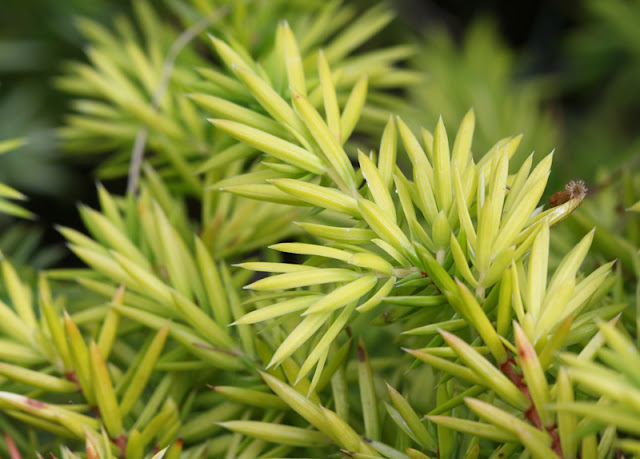
On the way back to the car, I photographed some Traveller's Joy, a climbing, wild Clematis found all over the chalk areas of Kent.
We then headed to Sandwich dunes, our last stop this day. It's home to hundreds of Lizard and Pyramidal Orchids in the late Spring and rarities such as Bedstraw Broomrape and Sand Catchfly as well. Of course, none of those species were to be found now, but here's what I did find.
Here's Sea Rocket, a member of the Cabbage family that not only tolerates salt water but has its seeds spread by the tides. As such, you often find it, as here, on the Spring high tide line.
When visiting in the Spring for the orchids, Sea Holly comprises of a few leaves poking out of the shingle or sand. They were now in full bloom and full of bees.
Dotted here and there were the bright pink flowers of Common Restharrow. In coastal areas it's worth checking for Spiny Restharrow, which as its name suggests has spines. however, to confirm ID check also the hairs on the stems and terminal leaf size to make sure. Common Restharrow is often found in arable fields as well as in coastal areas.
The final plant of note before the long journey home was the fluffy looking Haresfoot Clover. Tucked away in the hairy bracts are small white pea flowers.
Trifolium arvense
So ends another blog.
I hope it inspires you to look around you the next time you are out and about.
Take care
Dave
@Barbus59
The first area we walked was to the Bleriot Memorial from the Dover Castle overflow car park.
The area was in full bloom of the usual chalk loving flowers, but this Eyebright really got my attention due to its beautiful lilac shades. Most Eyebrights in the area are basically white with a yellow blob, so this was nice to see.
Euphrasia agg
Under the dark shade of the trees we found lots of Enchanter's Nightshade - what an inspiring name!
The photos show two colour forms commonly found in Kent. The first photo with the bright red sepals I've only seen where there is plenty of light, such as where a tree has fallen down or been cut down; the latter is always found in deep shade. It's as if the plant knows that when its in the light, it has to compete with other flowers for pollinators, so brightens itself up a bit!
Circae lutetiana
Buddleja has spread everywhere. If it didn't have beautiful flowers and provide a food source for many insects and butterflies, I'm sure it would be enemy number 1. It does like chalk and can completely dominate newly exposed areas. When a new road was dug through the chalk near Gravesend, within 10 years it was completely overgrown with Buddleja and not much else.
Here's one with a large bee mimicking Hoverfly on it.
Common Toadflax is one of the few plants left that has common in its name and is actually - common!
As such, I try to take photos from unusual angles to show the plant's beauty in a different way to usual.
Linaria vulgaris
View from under the flowers.
View from above the flowers.
Up until recently, I would have said this was Wild Parsnip. It's the only umbellifer with yellow flowers and big lobed leaves as shown.
However, there's two types*:
Wild Parsnip is densely hairy on the leaves and stem giving it a grey/green appearance (subsp sylvestris)
and
Garden Parsnip which isn't hairy and has bright green leaves (subsp sativa)
Since I found out aboout this interesting fact out I've looked at all I find, and they are all naturalised garden escape forms, sometimes known as Var. hortensis.
Pastinaca sativa subsp sativa
* there is 3rd, susbsp urens confined to the Suffolk area.

When out recording plants it's easy to assume a bramble is a bramble. There are numerous micro species of bramble and it's very easy to overlook other members of that family, such as this Dewberry.
When in fruit, the white bloom on the berries give it away. They really don't look like a Blackberry at all.
Also keep an eye out for Raspberries which are also relatively common in the wild.
Rubus caesius
Coastal areas around Kent teem with this next plant in Spring to early Summer. Brought over by the Romans, it is appropriately called Alexanders. Here I've photographed the rather attractive seeds of that plant. It can dominate an area, but it dies back in sufficient time for other plants to come up later in the year.
Smyrnium olusatrum
I found both the common Nightshades here, Woody or Bittersweet with its purple petals and yellow centre and this lovely Black Nightshade, which has white petals. It gets its name from its berries which go from green to red to black as they age.
Solanum nigrum
The last plant I photographed here was Vervain. It's got a tiny delicate off white to lilac flower on a tall, spindly stem. The second photo shows this clearly. They often flower after being cut by mowing, so can be only a few inches tall in such areas. Generally though, they are around 1-2' tall.
Verbena officinalis
From here, we drove the short distance to St. Margarets at Cliffe. This is one of the few beaches in the area that has realistic parking charges, I forget now, but it's something like 40p an hour! It has spectacular scenery as it nestles in a gap in the white cliffs of Dover. You can see all the ferries coming and going from Dover and easily see France on a clear day.
I walked along the sea front first, past the pub to the cliff edge. There I could see numerous Sea Lavenders growing in the cliffs. It turned out these were actually Rock Sea-Lavender, a rarity in Kent. Unlike the usual Common Sea-Lavender I find elsewhere in Kent, these branch below the middle and the flowers are sparser than usual as well.
Limonium binervosum
Near to habitation in this area was an impressive display of an alien invasion! Russian Vine had overwhelmed a whole cliff area, smothering everything. I doubt anyone would get a mortgage here as lenders take a dim view of this and other similar plants, such as Japanese Knotweed.
Russian Vine
Fallopia bauldschuanica
Part of a whole cliff face colonised by this garden escape.
I then went North to the other end of the beach to an area that had a cliff fall a few years back. There was precious little soil here and most of it was a few yards above the high tide storm mark.
There were a surprising number of chalk loving plants here, despite the lack of soil, such as this yellow glowing Kidney Vetch, beloved of a blue butterfly caterpillar, but I forget which now, I think possibly the Small Blue.
Anthyllis vulneraria
No longer in flower but in seed, however, they look great don't they! These are the seeds of Yellow-wort which has very bright yellow flowers that only open in full sun. Note how the stem appears to push through the leaves, an easy identifying feature for this plant.
Blackstonia perfoliata
Ploughman's Spikenard was another surprise, though it's common on chalk inland. Here it grew quite tall in a crack in the chalk boulders. Around it (see second photo) is Pellitory of the Wall and more Yellow-wort. The big green leaves to the right of the stem are those of Coltsfoot as well.
Inula conyzae
The next five photos could be of someone's garden plant, for that's what it is. Snapdragons were abundant here, often called Bunny Rabbit Ears by kids. I found two colour forms as well. I have found these spreading into the wild all through Kent of late. They are a Mediterranean plant, so our lack of cold Winters of late is obviously to their liking. However, they don't seem to have any effect on other plants, give a splash of colour and bees like them, so perhaps not so bad after all.
Antirrhinum majus
Rock Samphire is now in flower in droves, most of it on the cliffs and inaccessible, but there's usually a few plants at ground level for photos. The first photo also features a Sea Mayweed.
Crithmum maritimum
Juniperus communis

On the way back to the car, I photographed some Traveller's Joy, a climbing, wild Clematis found all over the chalk areas of Kent.
Clematis vitalba
We then headed to Sandwich dunes, our last stop this day. It's home to hundreds of Lizard and Pyramidal Orchids in the late Spring and rarities such as Bedstraw Broomrape and Sand Catchfly as well. Of course, none of those species were to be found now, but here's what I did find.
Here's Sea Rocket, a member of the Cabbage family that not only tolerates salt water but has its seeds spread by the tides. As such, you often find it, as here, on the Spring high tide line.
Cakile maritima
When visiting in the Spring for the orchids, Sea Holly comprises of a few leaves poking out of the shingle or sand. They were now in full bloom and full of bees.
Eryngium maritimum
Dotted here and there were the bright pink flowers of Common Restharrow. In coastal areas it's worth checking for Spiny Restharrow, which as its name suggests has spines. however, to confirm ID check also the hairs on the stems and terminal leaf size to make sure. Common Restharrow is often found in arable fields as well as in coastal areas.
Ononis repens
The final plant of note before the long journey home was the fluffy looking Haresfoot Clover. Tucked away in the hairy bracts are small white pea flowers.
Trifolium arvense
So ends another blog.
I hope it inspires you to look around you the next time you are out and about.
Take care
Dave
@Barbus59












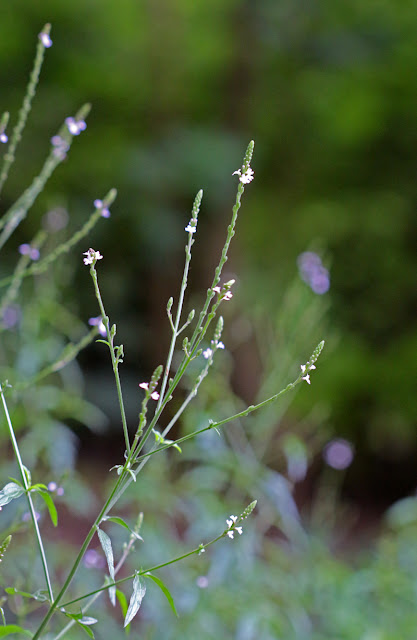





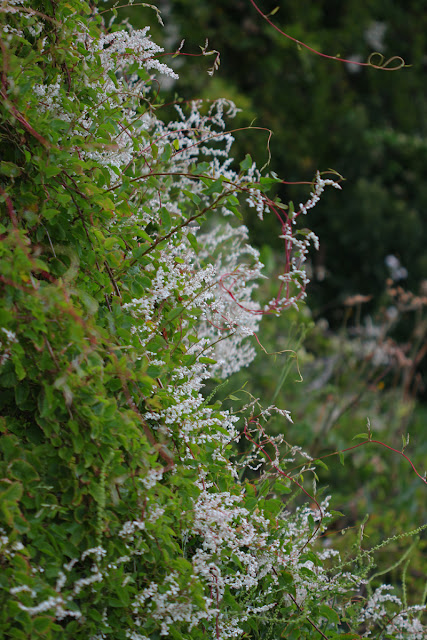
























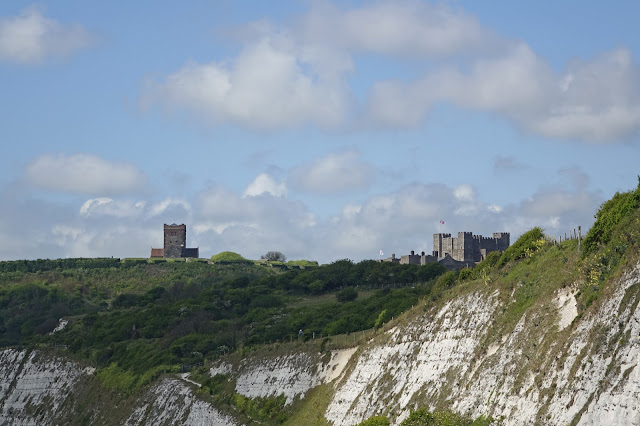
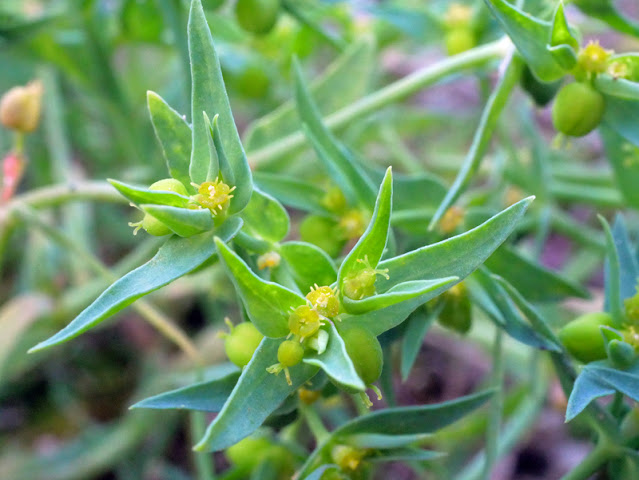
Comments
Post a Comment
Comments welcome from those interested in my articles. For spammers don't bother as I moderate all comments prior to posting them.